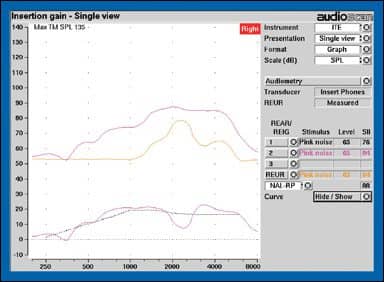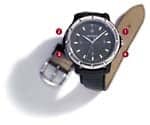
|
| Michael Poe – MedRX Inc |
Imagine a patient visiting an eye care professional, complaining of blurry vision, problems judging the distance of objects, and a general limited ability to see. The specialist performs a vision examination and fits the patient with corrective lenses. The patient leaves the office and walks smack into a street sign, lamppost, or oncoming traffic—all because the corrective lenses were not the appropriate fit. Hard to imagine, right? That’s because vision specialists rely on objective standards to ensure a proper fit. Patients with vision impairment have come to expect the proper corrective lens fit for their needs right from the start.
But what is now commonplace for individuals who are vision impaired is all too often an ongoing quest for individuals who are hearing impaired. “As an industry, we need standards and consistency in our fitting delivery system,” says Michael Poe, a consultant with Largo, Fla–based MedRx Inc. “There are over 13,000 dispensers in America; as a patient, you can walk out with 13,000 different opinions.”
According to the American Academy of Audiology, Reston, Va, hearing loss is the third most common health problem in the United States, accounting for more than 31 million Americans with some type of hearing problem. Yet, according to the National Institutes of Health, Bethesda, Md, only one out of five people who could benefit from a hearing aid actually wears one. While there is no hard evidence, experts agree that lack of compliance is often due to improper fit.

|
| Kristina Frye – Frye Electronics Inc |
The good news for patients and hearing health care professionals is that it doesn’t have to be this way. Mastering the art of proper fitting begins by embracing today’s state-of-the-art tools.
GETTING IT RIGHT—FROM THE START
Experts in the industry say too many hearing health care professionals rely on “first fit,” which is based on manufacturers’ software. “Many times, audiologists depend on manufacturers’ best fit,” Poe says, “but these are predictions at best; they don’t take into account the volume and size of the ear canal.”
Why is it so important to get a proper fit the first time around? Naturally, repeat visits with patients cost hearing health care professionals time and money. There is also the issue of compliance. “If the fitting isn’t good, the hearing aid might end up in a drawer of a frustrated patient, benefiting no one,” says Kristina Frye, project manager at Frye Electronics Inc, Tigard, Ore. “Even worse, from an industry point of view, the patient may tell their friends and relatives that hearing aids ‘don’t work right’ and discourage other people who may need one.”
Fitting technology has come a long way in a short time. While real-ear measurement (REM) has been around for 2 decades or so, experts in the industry say the technology has evolved in recent years. What’s more, speech mapping only came on the market in the 1990s, and many hearing health care professionals are still discovering its value.
Today, there are ample sophisticated fitting tools from which to choose. Getting the job done right—that is, achieving a proper fit for patients—is the first priority. However, finding the “right fit” for your practice is important, too: Are you more comfortable with a particular technology? Do you work out of multiple offices and require something portable for your practice?

|
| Peg Horan – Interacoustics |
With a variety of offerings from today’s manufacturers, hearing health care professionals can find the perfect fitting tool for their business needs as well as their patients’ needs.
“One of the biggest challenges of fitting is to create realistic expectations,” says Peg Horan, national sales manager of Interacoustics®, Minneapolis. “Patients and family members often think that when they put on the hearing aid they will hear perfectly.”
The new generation of hearing aid users is a far more demanding customer. “Baby Boomers will not come back five or ten times to get the fitting right,” Poe says. “They are not as patient as my mother’s generation. And, they are a lot more inquisitive, educated, and affluent.”
The new fitting systems available in the industry are ideal for today’s patients. “With Baby Boomers, there is a critical need to engage the person in the process,” Poe says. “Our systems are educational tools that provide dynamic presentations where the patient can see how a proper fitting is achieved.”
The latest fitting tools use a screen to show patients visually where their hearing loss is located. “It’s like a counseling tool, because the whole fitting process makes more sense to the patient,” Horan says. “For example, they [can] better understand challenging situations, like hearing in noise or [hearing] mumbling.”
ON THE MARKET
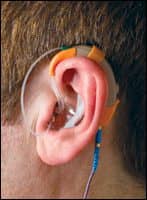
|
| Interacoustics’ Affinity |
Interacoustics’ Affinity system, which has been on the market for approximately 2 years, is a hardware and software platform that offers multiple choices for hearing aid, real-ear, and audiometric examinations.
The product encompasses four software modules and can be purchased as a whole or in parts. In addition to the audiometer module, there is a hearing instrument test box, which checks the acoustics and functionality of the hearing aid. The Affinity’s REM module features a wide range of possibilities within fitting and troubleshooting tools, including measurement of various signals that allow for accurate hearing aid fitting even for digital hearing aids.
The final module—visible speech—uses voice and recorded sounds to truly involve the patient and determine the best possible fit. Clinicians can use it to demonstrate on a computer screen the difference between normal hearing and a patient’s particular hearing loss. This helps clarify the patient’s perception of sound to himself or herself, and also to family members. “For example, with the visible speech module, patients and relatives have a better understanding [of] why, even with a hearing aid, a person may not necessarily hear clearly if they are standing at the sink with water running,” Horan says. “When you combine traditional real-ear measurement with visible speech, the clinician has a cross-reference tool that makes for a better fitting.”

|
| Audioscan’s Verifit Reflection |
The Affinity is designed to help hearing health care professionals meet three key objectives of a fitting. “The goal is to ensure that soft sounds are audible, average speech is comfortable, and loud sounds are tolerable,” Horan says.
Based in Dorchester, Ontario, Canada, Audioscan® manufactures two hearing instrument fitting systems, the desktop Verifit® and the portable RM500 SL. The equipment verifies the audibility of real speech and the comfort of loud sounds. It also demonstrates the functioning of adaptive microphones, noise reduction systems, and feedback-suppression systems on the ear and in the test box.
“In the past, tones and noise, either steady or modulated, were used in an attempt to predict performance of speech. This works for simple linear hearing aids, but fails when compression and various digital processing schemes are present,” says Audioscan’s president, Bill Cole, BASc, PEng. “Our second-generation products are the first to test hearing aids utilizing real speech that is both well controlled and analyzed in such a way that it can be directly compared to behavioral measures such as threshold [and] comfortable and uncomfortable levels.”
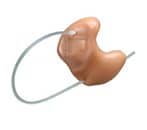
|
| Bill Cole – Audioscan |
Hearing aids can now be fitted using the signal they were designed to process—speech—and the fitter can see what usable information is being provided to the patient on a variety of levels, conditions, and processing options.
The industry has made significant advances in directional testing, too. For instance, Cole says Audioscan’s Verifit system can show directional function in real time with all of a hearing aid’s adaptive features enabled, using a unique, patented, dual-source directional test. “Shortly, we will be extending this test so that it works with aids that adjust their directional response to optimize signal-to-noise ratio,” Cole says.
Audioscan also recently introduced the Sensory Loss Simulator™, a cochlear hearing loss simulator available as a feature on the Verifit and the RM500. Using a patient’s audiogram, the tool demonstrates the inability to hear soft sounds and the near-normal loudness of loud sounds that characterize most hearing losses. “It helps teachers, parents, and other family members understand how frustrating and disruptive a hearing loss can be,” Cole says. “Previously, the only available simulations mimicked an earplug—just turning down the volume.”
The AVANT™ system from MedRx is offered as a complete audiological suite. It features dual-channel audiometry, hearing instrument test box, hearing loss simulator, real-ear measurement, and live speech mapping (LSM). For the fitting process, speech is used as the input stimulus.

|
| MedRx’s AVANT |
“With the AVANT, you can see the components of speech that the patient is or is not hearing,” Poe says. “It makes standard clinical real-ear measurements more meaningful and enjoyable for the patient, family, and clinicians.”
According to MedRx—the company that pioneered LSM—the key to a successful fitting using LSM is the ability to use a patient’s dynamic range as the target, ensuring that soft speech is audible, conversational speech is comfortable, and loud speech and sounds are tolerable. In addition, the AVANT verifies that noise reduction circuitry is working and ensures that directional microphones are meeting specifications. The AVANT’s graphic user interface is Windows® based, and the system performs within NOAH™ and TIMS® software, allowing all data to be saved to the NOAH and TIMS databases.
MedRx’s AVANT REM Speech is identical to the full AVANT but measures just 4 x 4 inches and plugs directly into a computer. A flexible system, the modules can be purchased individually. In addition, MedRx offers a “mobile office,” comprising the REM Speech product packaged with an audiometer. “It comes in a satchel the size of an executive planner,” Poe says. “It’s a full dispensing clinic in a briefcase.” This kind of fitting system can be ideal for professionals who work out of several locations or those attending health fairs or other clinical events.
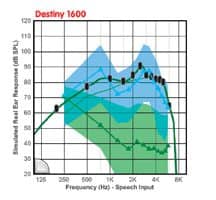
|
| Frye Electronics’ FP35 Monitor |
Frye Electronics offers two hearing aid analyzers: the FONIX 7000 Hearing Aid Test System, which is used by clinicians, universities, and hospitals; and the FP35, a small, portable model designed primarily for hearing aid clinics, educational audiologists, and teachers of the deaf. The FP35 was first released in 1999, but has gone through extensive upgrades since then. Both systems use the HIMSA-certified FONIX NOAH Module along with WinCHAP software, a stand-alone database program.
The FP35 analyzer includes the traditional insertion gain method of performing real-ear measurements, as well as the newer sound pressure level (SPL) method. All real-ear measurements are automatically converted when switching between insertion gain and SPL screens, allowing the clinician to view test data from different perspectives without requiring duplicate measurements. “One of the nice features of the FP35 is that any measurement performed one way will show up the other way as well,” Frye says.
While visible speech testing can be performed on both systems, the 7000, introduced in 2003, features a special test screen exclusively for this function. The real-time response and the long-term average response are both displayed on the screen. The equipment also records the minimum and maximum response of the hearing aid to the speech signal. All of these measurements can be directly compared to the patient’s threshold and uncomfortable levels. “Our FONIX NOAH Module has a very simple interface and automation options that make testing faster and easier,” Frye says. “The ability to perform multiple real-ear frequency responses automatically has been particularly useful to clinicians, and we are planning on expanding this capability in the future.”
ON THE HORIZON
Clearly, the hearing aid fitting process has come a long way, thanks to technological innovation. But today’s manufacturers are not resting on their laurels; they continue to create new solutions for ongoing challenges.
For example, there is currently a bandwidth limitation with real-ear measurements. Most only test out to 8,000 Hz, even though many hearing aids now provide a frequency response giving amplification past 8,000 Hz. “Ideally, real-ear measurements should be able to measure higher frequencies,” Frye says. “We’ve been working on improvements to our analyzers that will lead to higher frequency measurements.”
In addition, Frye Electronics is working with National Acoustics Laboratory in Australia to develop a new product called HEARLab that measures the patient’s cortical response to auditory signals. Cortical measurements are useful in estimating thresholds in patients who are unable to cooperate in standard audiometric testing, such as infants, children, and adults who are disabled. They are also useful in testing aided patients and determining whether the cortex of the brain can detect the test signal. FDA approval is expected this summer, and the company hopes to start manufacturing by the end of 2007.
 |
| When it comes to hearing aid fittings, do you rely on manufacturers’ first-fit software or do you use one of the independent fitting systems available on the market? Let us know by voting in our June Web poll, on the left side of the home page under Top News. |
MedRx plans to launch new fitting software components by mid-May. “We will be introducing a new open-fit function as well as the addition of NAL-NLI fitting formula,” Poe says.
At Interacoustics, Horan says the company is continuously focused on development, with new fitting products slated for release in 2008.
Audioscan is working on a new fitting/testing feature called Viewport™, which will allow all of the important fitting steps to be completed and documented in a short time. It yields a complete snapshot of digital hearing aid performance, distilled and documented on one screen or printout. “Viewport also smooths [the way for] counseling and helps make the fitting a cooperative event rather than just a prescription the patient has to live with,” Cole says. “We see this as a valuable tool in demystifying digital hearing aids for both patients and dispensers, and an important step toward evidence-based practice for our customers.”
Marianne Matthews is a contributing writer for Hearing Products Report. For more information, contact [email protected].

